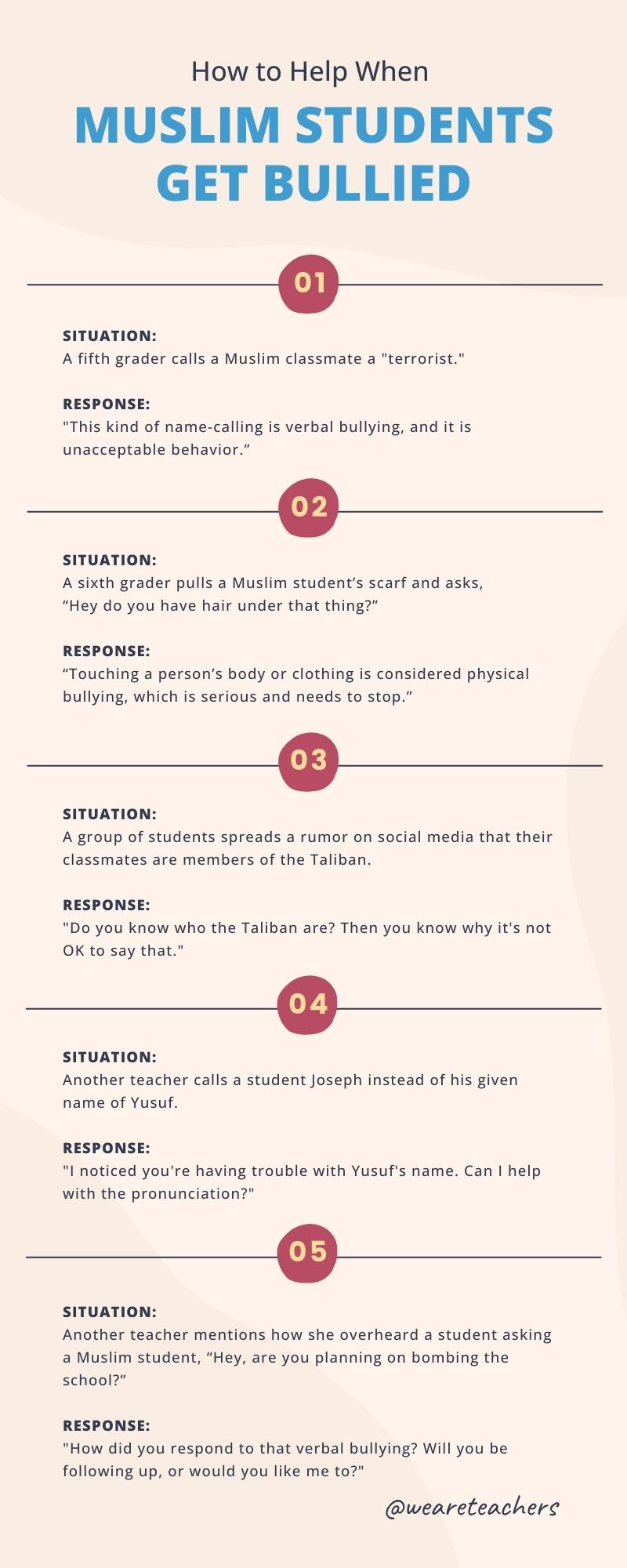“I have had my hijab pulled off by a classmate for no reason.”
“People would make jokes about 9-11 towards me and make me feel like I was to blame for it.”
“Someone asked me if I was going to blow up the school and if I was reading a book on bombs.”
Bullying against Muslim students is happening all across this country. It is real, it is ugly, and it is happening way more often than you might think. According to a 2022 survey by the Institute for Social Policy and Understanding, 48% of Muslim families reported that their child had been bullied because of their faith. And 20% of Muslim students report that bullying happens nearly every day. If we learned anything in teacher college, it’s that students who don’t feel safe at school can’t learn. And we know from long experience the negative effects of bullying on mental health and overall well-being.
So, what can we do about it? We can teach lessons on racism. We can make sure all students see themselves reflected in books and materials. And perhaps most important, we can respond in the moment to bullying. Unfortunately, many of us feel unsure about how to intervene when that bullying is about someone’s identity. So we worked with the folks at ING to give you the words. ING developed a free digital presentation for teachers called “Countering Islamophobia in Education” that discusses Islamophobia or anti-Muslim racism and its roots, its impact on Muslim students and their families, and ways to counter it.
Consider the following bullying situations and practice your responses so that you’re ready to tackle them head-on if and when they happen in your own school.
Bullying Situation #1: A fifth grader calls a Muslim classmate a “terrorist.”
Your Response: First and most important, you need to stop the behavior. Say, “This kind of name-calling is verbal bullying, and it is unacceptable behavior.” Ensure that the student who was targeted is in a safe space away from the student who was bullying. Then ask them how they would best feel supported, such as by talking to their parent, friend, sibling, or a counselor. If this is a first-time offense for the student who is bullying, you may need to do some education around why this comment is hurtful and unacceptable. Consider using restorative justice practices to attempt to repair the harm, which would include an apology.
Bullying Situation #2: A sixth grader pulls a Muslim student’s scarf and asks, “Hey do you have hair under that thing?”
Your Response: First and most important, you need to stop the behavior. Say, “Touching a person’s body or clothing is considered physical bullying, which is serious and needs to stop.” Ensure that the student who was targeted is in a safe space away from the student who was bullying and offer them support and reassure them that this behavior will not be tolerated. Inform the student who was bullying that unwanted physical interaction is reason for referral or suspension if repeated. Monitor the student who engaged in bullying to ensure this behavior does not reoccur.
Bullying Situation #3: A group of junior high students spreads a rumor on social media that a couple of newly immigrated Afghan Muslim classmates are members of the Taliban.
Your Response: Pull together the students who took part in spreading the rumor. Do not involve the targeted students as you don’t want them to feel like they hold any responsibility for what happened. Try to find out the source of the rumor and the reason for starting such a rumor. Then make sure that everyone involved understands the impact of such a rumor and that anyone who passed along the rumor knows they were part of the cyberbullying (sometimes kids don’t think they’re part of the problem if they didn’t start it).
Ask, “Do you know who the Taliban are?” If the answer is yes, then they know why the behavior isn’t OK. If it’s no, then it’s a teachable moment for you to explain to the students who the Taliban are and that they should avoid using terms unless they know their meaning as they can be insulting or stereotypical. Additionally, consider holding a school assembly that addresses these issues, including the impact of cyberbullying and the consequences of participating in such actions for all involved, including bystanders.
For more information about the Taliban visit “A Muslim American Perspective on the Return of the Taliban in Afghanistan.”
Bullying Situation #4: Another teacher calls a student Joseph instead of his given name of Yusuf.
Your Response: Approach the teacher in private and discuss the importance of using a student’s correct name. Since all of us want to be seen and respected for who we are, saying our names the right way is part of that. This kind of substitution happens often in schools, but it’s not OK and could even be considered a microaggression! Try saying, “I noticed you’re having trouble with Yusuf’s name. Names are super important. Can I help you get the pronunciation down?” Additionally, it’s important to ask a student their preference on what name they want to go by; some students may want to go by an anglicized version of their name.
Bullying Situation #5: During lunch in the staff room, another teacher mentions how she overheard a student asking a Muslim student, “Hey, are you planning on bombing the school?” during passing period.
Your Response: Ask the fellow teacher what steps she took to respond to the bullying incident. If she says that she thought it was just a joke, firmly explain to her that verbal bullying is serious and should be treated as such, regardless of the student’s intention. Politely inquire if she will be following up with the two students or if she would like you to. Follow through to make sure the incident is appropriately addressed and if not, report it to administration.
Learn more about how to support your Muslim students and prevent bullying with more resources from ING. Teachers can also help Muslim students by utilizing tools on the INGYouth website.

Get Free Resources on Teaching About Muslims and Their Faith

